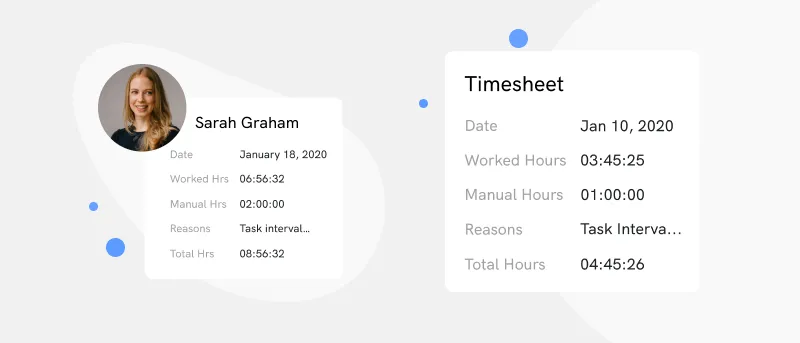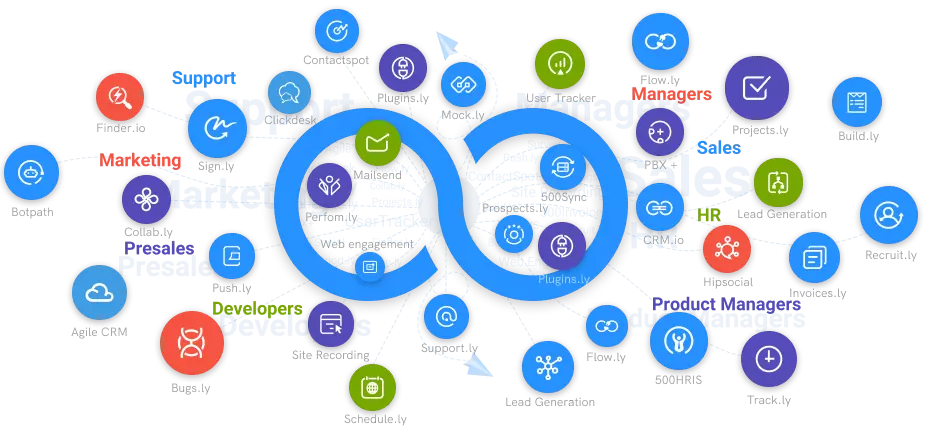What is Time Tracking?
Time tracking is a business asset that helps increase productivity and ensure profitability.
#1
Get an instant preview of employee activities - timesheet, keystroke & mouse click logging
#2
Monitor in real-time by automatically capturing screenshots of employee's screen
#3
Take control of employee work hours for better project planning
#4
Utilize the project management functionalities to deliver your projects on time
#5
Add unlimited projects and manage all in one place
#6
Customize the screenshots interval and mouse / keyboard activities
#7
Integrate with popular project management tools such as Projectsly
#8
Automate payroll & expense claims with the online time-sheets
#9
Unbelievable pricing - the lowest you will ever find
#10
Everything your business needs - 50 apps, 24/5 support and 99.95% uptime
Time tracking is the recording of time spent working on tasks and projects. Records of time tracking date back to ancient BC times. The first attempt of tracking time occurred around 3500 BC when Egyptians used obelisks and its shadows when the sun hits it to measure time. But it wasn't until 200 years later that workers would be compensated for their work and that their wages were documented using Cuneiform writing. During this time, workers were paid with food or beer for an entire day's worth of beer. Employee time tracking and hourly rates didn't exist yet.
In this piece let's dig deeper into what is time tracking.
Though hourly rates didn't exist in the history, humans were slowly evolving towards it. Around 1,500 years passed before the first known fixed project rates were born when The Code of Hammurabi was created. Some of its laws gave fixed-rate wages to specific occupations. And workers would also get paid more or less depending on their customer's or patient's social status.
And for centuries, people continued measuring time using various methods while employees were still paid for the entire day, with fixed rates, or their employers relied on inaccurate employee time clocks.
But it wasn't until the industrial revolution and child labor when the government stepped in and limited how many hours children can work. And in 1888 when Willard Bundy invented the employee time clock employers from all around the country started using machinery to calculate the hours their employees worked and was known as the first employee time tracking software.
![]()
While it wasn't perfect, it was the start of hourly work and employees getting paid for their time worked. Over time the employee time clock evolved and in 1979, the first employee punch card system was created. And although punch cards were an efficient option, at first, workers started finding loopholes and committing various forms of time theft. One common type that's still present with punch cards today is buddy punching.
As technology grew, however, more advanced forms of employee tracker software started emerging. Such as the electronic spreadsheet, time tracking solution, and biometric time clock, to name a few.
With the rise of newer methods of time tracking and access to automatic time tracking solutions, businesses started to realize that tracking their employees time can be used for more than just processing payroll.
But, before we talk about how time tracking facilitates business success, we need to understand the problems businesses face that can be solved or better managed with modern employee time tracking.
Common Business Problems
Some business problems can at least be remedied with employee time tracking. Let's take a look at a few of them to understand what is time tracking and the problems businesses face.
Lack of Profits
One common problem that most small businesses face is a lack of profits. There are many factors that tie into why a business might not be profitable, but one of the simplest reasons is that their expenses are far greater than their revenue.
If you have more than enough clients to make your business profitable--but it's just not happening--then there's a deeper underlying problem that you need to address. However, it's impossible to fix a problem quickly without having records of where it's coming from.
Time Theft
Time theft is when an employee is getting paid for hours that he or she didn't work. There are many ways that employees can deceive employers and commit time theft. One of the most well-known methods of doing this is by adding hours to one's timesheet that were not completed. When you're using a punch card or a paper timesheet, it's easy for employees to create false reports.

Another way that employees commit time theft is through “buddy punching. When a coworker knows that another employee will be late to work, when asked, they might clock them in hours before they arrive. If you're using punch cards, it's difficult to tell if an employee is at work or not.
Overtime
Overtime for employees can become an expense that can create hardship for both the business and the employee. Unfortunately, when you don't have adequate systems in place to know when an employee is close to crossing that threshold, it's hard to put a stop on it and delegate that respective task to an employee who has a smaller workload.
Inaccurate Estimates
Whether you're measuring project length or budget, having inaccurate estimates makes it hard to stay within the allocated budget or get the project done within the specified time frame. These inaccuracies can lead to mistrust between your business and your clients, scope creep and going significantly over your budget.
These problems, if not taken care of can drastically harm your business and its growth. Luckily, each of these problems, in some way, can be solved with time tracking. Here are a few benefits that time tracking can have for both your business and your employees.
Benefits of Modern Employee Time Tracking
With accurate, trustworthy timesheets at their disposal, employers can use it to track their employees performance. Performance monitoring can provide insightful data surrounding employees strengths and weaknesses, productivity levels, work patterns, and more. Additionally, businesses also use it to delegate tasks, monitor projects profitability and scope creep and create more accurate project estimates.
![]()
So, overall, employee time tracking is more than just a helpful solution for HR, it's also a strategic benefit for businesses so they can see exactly where their most important resources - time and money are going.
Is Automatic Time Tracking Solutions Right for Me?
Everyone can benefit from accurate time tracking. Because there's always a way to work more efficiently or increase our productivity. We're only given 24 hours every day, why not try and make the most of it?
Anyone from productivity-enthusiasts to employers needs accurate time tracking software like Clockly. Productivity-enthusiasts can use these systems to get the most out of their day. Freelancers can use it to accurate bill their clients and justify increasing their hourly rates. Employers can use it to identify what tasks and departments are using most of their project budgets, confidently process payroll, better manage their teams, and much more.
Ultimately, whether you're indecisive about software for time tracking or not, we all can benefit from not wasting our time on inaccurate timesheets and being inefficient.





